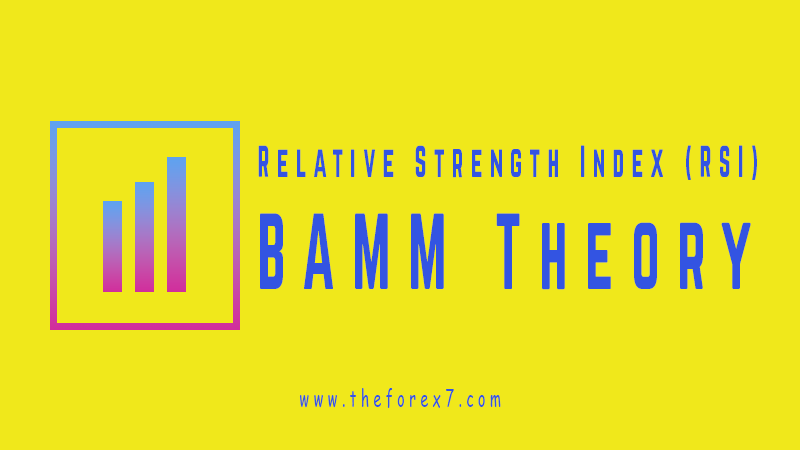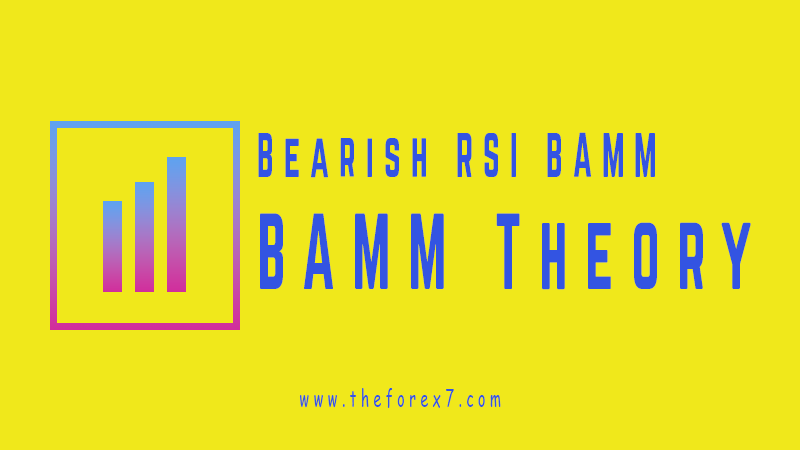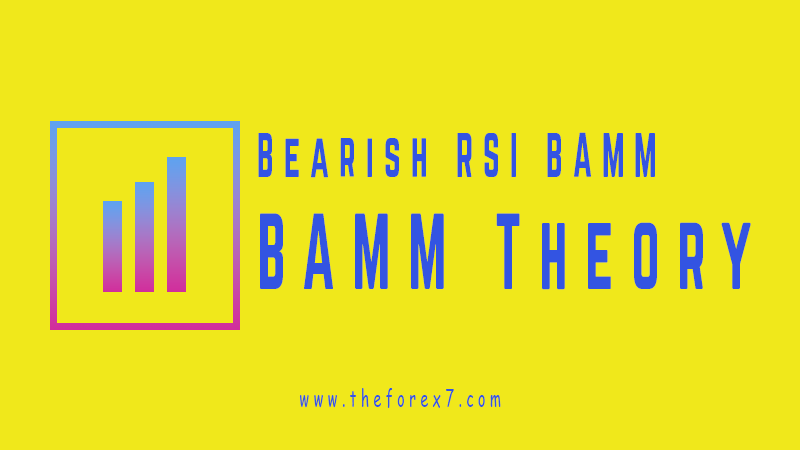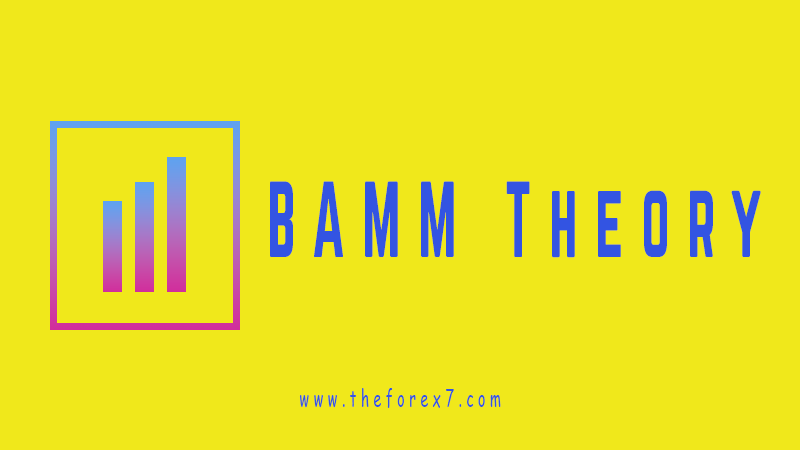BAMM Theory: Bullish RSI BAMM
Define Bullish RSI BAMM, Two types of bullish indicator, Steps in Bullish RSI BAMM, Bullish RSI BAMM : (CVX), Bullish complex indicator,
Course: [ HARMONIC TRADING : Chapter 6: RSI : Relative Strength Index (RSI): BAMM Theory ]
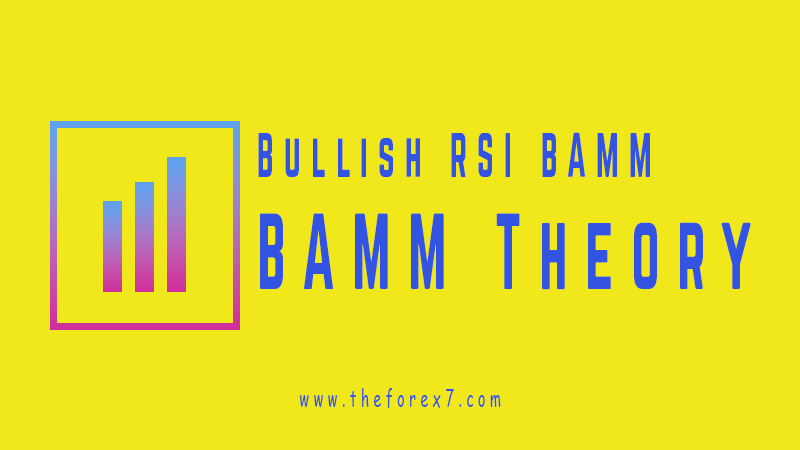
The Bullish RSI BAMM begins with a complex reading in an oversold area under the 30 limit. Referring to the RSI BAMM the entire process requires several elements to validate this specific scenario.
BULLISH RSI BAMM
The
Bullish RSI BAMM begins with a complex reading in an oversold area under the 30
limit. Referring to the RSI BAMM illustration in Figure 6.1, the entire process requires several elements to
validate this specific scenario. In much the same manner that the initial rules
of harmonic pattern identification and differentiation may have seemed
overwhelming, the RSI BAMM rules—albeit a bit complex upon first study—provide
a coherent and comprehensive method for accurately measuring potential areas of
divergence.

FIGURE 6.1
Obviously,
the ideal situation does not occur every time. It is important to remember that
the real application of the RSI BAMM principles requires a degree of
flexibility. However, the ideal model does present all of the critical elements
that clearly explain the effectiveness of this strategy. Furthermore, it is essential
to maintain the patience to execute only those trades that possess all required
elements that validate a trade signal based upon the rules of the Bullish RSI
BAMM setup.
Despite
its initial complexity, the RSI BAMM strategy in combination with harmonic
patterns effectively validates PRZs and offers an enhanced level of precision
and accuracy.
CHEVRON-TEXACO
(CVX): DAILY
BULLISH RSI BAMM
The
example of Chevron-Texaco in Figure 6.2
shows an excellent RSI BAMM setup on the daily chart. Figure 6.2 does not display all of the critical details of the RSI
BAMM; rather, the Chevron-Texaco chart manifests all of the basic elements to
validate this setup.

FIGURE 6.2
This
example of Chevron Texaco shows a distinct RSI BAMM setup. The initial complex
RSI formation established the beginning of the entire process, and the
indicator completed the necessary steps to validate the setup. Although I will
outline the advanced concepts later in this chapter, it is important to review
this chart carefully because it truly exemplifies all of the ideal elements of
the RSI BAMM.
STEP 1: INITIAL RSI TEST OF EXTREME BULLISH LIMIT
In
the Bullish RSI BAMM scenario, the first step is to identify price action that
possesses an RSI reading in the extreme oversold zone below 30. As I mentioned
previously, it is important to note that the 30 level for the oversold limit,
as well as the 70 level to define the overbought area, were first outlined by
Welles Wilder in his book New Concepts and Trading Systems. In addition, a
14-period average is calculated from his approach. Although this system
utilizes the standard RSI measures, the indicator can be refined to utilize
other levels and time periods to define the extreme Relative Strength levels. I
leave that to you to research. I have experimented with other periods, and
these results have yielded excellent confirmation signals. In general, the
standard parameters above a 70 reading as overbought and below the 30 limit as
oversold with a 14-period average serve as the best guidelines for the entire
RSI BAMM approach. Besides, who am I to disagree with Welles Wilder?
STEP 2: COMPLETE A BULLISH W-TYPE COMPLEX RSI STRUCTURE
One
of the reasons why the RSI BAMM is so effective is because it requires that the
entire structure of the indicator form below the oversold 30 level before a
trade signal can be generated. This is advantageous because the RSI structure
can be distinguished while still allowing for enough time for the price action
to set up correctly to validate the entire technique. The initial focus should
be on the formation of the indicator reading in the entire extreme range rather
than looking for a specific numeric level.
This
is a mandatory requirement of the RSI BAMM, where all points of the W-type
formation must take place below the 30 level. It is important to remember that
this is an early signal, and the price action quite frequently will continue in
the predominant downtrend after the W-type structure has formed. But, this
marks the initial stage of the divergence setup, where the price action
continues lower, while the RSI stabilizes and begins to move higher. However,
due to the variety of indicator structures that form in the oversold area, it
is important to differentiate the two types that form at RSI extreme levels.
TWO TYPES OF BULLISH INDICATOR STRUCTURES
There
are two general classes of W-type indicator structures that test the extreme
oversold level—impulsive and complex. Most bullish indicator readings that are
below 30 will be impulsive in nature and will not yield the required structure
to be considered a valid RSI BAMM setup. However, valid complex structures that
are correctly identified offer a tremendous technical advantage because they
are particularly unique and represent a vital potential reversal area within
the overall trend of the price action. The primary focus of the initial step is
to identify a complex RSI W-type structure in the extreme oversold area under
the 30-limit.
BULLISH IMPULSIVE INDICATOR STRUCTURES
A bullish impulsive indicator structure reflects price action that is experiencing a quick test of the extreme oversold support area, and it can typically reverse quickly without any consolidating price action (see Figure 6.3). Since the price action commonly reverses sharply in these cases, the indicator reading rallies above the extreme limit above 30 typically within 1 or 2 price bars of the initial test.

FIGURE 6.3
Although
such impulsive formations may test the extreme bullish RSI level, it is
important to focus on the nature of the indicator structure and not necessarily
the exact numeric reading (as long as it is below the 30 limit). The exact
indicator level is important in quantifying the extreme state of RSI, but the
general indicator formation is the critical factor that serves as the essential
trigger to validate a potential trade opportunity.
CHEVRON-TEXACO
(CVX): DAILY
BULLISH IMPULSE
INDICATOR STRUCTURE
In
this example, Chevron-Texaco possessed an ideal impulsive structure (see Figure 6.4). It is important to
note the sharp nature of the test of the extreme oversold area, as both the
price action and the RSI reading reversed immediately after sinking below the
30 level.

FIGURE 6.5
Impulsive
structures like these can be effective technical measures as they serve to
confirm bullish patterns and other trading signals. However, it is important to
note that the signals generated from extreme RSI readings do not constitute a
comprehensive approach to trading the market. As I mentioned previously, I
believe this is a common misconception in the application of the Relative
Strength measure, and for that matter, most other technical indicators and
oscillators. In my opinion, such technical measures must be utilized as a complementary
methodology rather than as an exclusive approach. A Relative Strength reading
below the 30 limit does not automatically signify a trade opportunity. In fact,
certain extreme impulse structures can signal significant continuations of the
predominant trend. These strategies will be covered later in the book. For now,
it is important to keep in mind the two different types of structures.
Furthermore, as is the case with all technical indicators, other methods must
be employed to validate any potential trade opportunity on a multiple
confirmation basis.
BULLISH COMPLEX INDICATOR STRUCTURE
A
complex structure represents an indicator formation that initially exceeds the
30 level and forms a W-type pattern entirely in the extreme area, as
illustrated in Figure 6.5. The
complex structure typically remains below the oversold 30 limit longer than an
impulsive formation.

FIGURE 6.5
Despite
representing a more significant technical condition than an impulsive
formation, the bullish complex structure is usually an early trading signal. In
fact, it is common for price action to continue to decline sharply in price,
while the complex RSI structure is developing in the oversold range under the
30 limit. Although the advanced concepts will be clearly presented later in
this chapter, it is important to keep in mind that a complex indicator reading
is merely the starting point for the entire approach, not the defining event of
the methodology. Furthermore, the complex formation establishes the beginning
of the most critical aspect of the entire RSI BAMM methodology—divergence.
CHEVRON-TEXACO
(CVX): DAILY
BULLISH COMPLEX
INDICATOR STRUCTURE
The
chart in Figure 6.6 shows an
excellent complex RSI structure, as the stock formed a distinct W-type pattern
in the extreme oversold area under the 30 level.

FIGURE 6.6
It
is important to note that the critical divergence stage begins after the
completion of the complex Relative Strength reading. After a period of
consolidation, the indicator stabilizes while the price action continues to
decline. Although the price action may seem to be maintaining its current
downtrend, valid complex bullish RSI structures usually trigger a reversal
sooner rather later. However, these structures mark critical support levels
well before a potential change in the overall direction, but this situation
typically requires a secondary retest before completing the reversal.
Although
a few other elements must fall into place for the Bullish RSI BAMM to be
validated, the formation of a complex RSI structure triggers the starting point
for the entire process. Again, this is an early signal, and it is critical to
wait for the W-type structure to break above the 30 line to confirm its
completion. After the complex RSI structure has been established, the other
considerations of potential pattern completions and specific RSI BAMM harmonic measurements
can be projected to determine the optimal reversal area. This leads us to our
next step, which includes defining and measuring the price level that triggers
this breakdown.
STEP 3: DEFINE THE RSI TRIGGER BAR
After
defining the complex RSI formation, the next step requires a measurement of the
price area where the W-type indicator structure has completed. The price bar
that causes the bullish complex RSI indicator reading to complete and to rally
above the oversold 30-limit is known as the RSI BAMM Trigger Bar.
After
identifying the RSI BAMM Trigger Bar, it is critical to mark the bottom of this
price bar by drawing an extended line from the low, projecting the minimum RSI
BAMM support level to the right of the chart (as is illustrated in Figure 6.7).
This RSI BAMM Trigger Bar support line serves as a minimum technical level for
the corresponding retest and the anticipated execution area of the completion
of the final phase of the RSI BAMM.

FIGURE 6.7
CHEVRON-TEXACO
(CVX): DAILY
RSI BAMM TRIGGER
BAR
From
a general perspective, the trigger bar as defined by the completion of the
complex RSI structure denotes the starting point for the critical divergence
phase that the entire methodology is attempting to define and quantify (see Figure 6.8).

FIGURE 6.8
From
a broader perspective, the RSI Trigger Bar can reveal a great deal about the
validity of the setup and the state of the potential price action. For now, the
most critical element of the RSI BAMM approach begins after the indicator has
reversed from the oversold area by completing a complex W-type structure.
The
position of the Bullish RSI BAMM Trigger Bar in relation to the prior extreme
low point is critical. Although its significance will be further explained
later in this section, it is important to remember that the Bullish RSI BAMM
Trigger Bar typically will be the price bar that is the exact prior low of the
current move or within a few intervals of the extreme low. The trigger bar is
critical because it marks the completion point of the complex RSI structure. In
essence, it is the price bar that completed the W-type structure and rallied
the indicator reading above the oversold 30 level to generate a significant
technical signal.
STEP 4: REACTION OF RSI AND PRICE
After
the initial pop following the completion of the complex RSI structure, the
price and indicator begin to decline in tandem (see Figure 6.9). Frequently, this initial breakdown offers a
distinct trading opportunity, but these strategies will be covered a bit later
in this chapter. However, the initial breakdown still requires a few elements
to be satisfied to realize the completion of the RSI BAMM.

FIGURE 6.9
CHEVRON-TEXACO
(CVX): DAILY
REACTION OF RSI AND
PRICE
After
the RSI BAMM Trigger Bar has been established and the price action rallies
following its completion, there will typically be a breakdown of this brief and
sharp rally. In the case of Chevron-Texaco, the price action rallied
sharply—establishing the first phase. After completing the RSI BAMM Trigger
Bar, the price action and indicator reading began to roll over immediately
after violating the brief yet sharp uptrend line (see Figure 6.10).

FIGURE 6.10
In
all cases, when the price action rolls over after violating the uptrend line
following the RSI BAMM Trigger Bar completion, the final phase of the entire
RSI BAMM process begins. However, there is one condition for the initial
reaction following the completion of the complex RSI indicator structure. This
specific type of retest is a mandatory condition before the final stage of the
RSI BAMM completion can be realized.
SPECIFIC TYPE OF RSI RETEST
This
specific type of retest is one of the most critical aspects of the entire RSI
BAMM methodology. The RSI reading MUST retrace to at least the 50 level before
the final retest can occur (see Figure
6.11).

FIGURE 6.11
Although
there is room for interpretation as the RSI reading may exceed the 50 level on
this initial reaction, it serves as a minimum requirement to distinguish the
most ideal situations. The mid-point retracement for the RSI reading is an
important intermediate step that precedes the corresponding retest and the
final phase of the RSI BAMM. This condition serves as a sufficient correction
of the initial extreme RSI reading before establishing the final divergence.
Let’s look at the Chevron-Texaco example to illustrate this mandatory retest.
CHEVRON-TEXACO
(CVX): DAILY
RSI BAMM TRIGGER
BAR
In
the Chevron-Texaco example, the stock tested the minimum mid-point RSI line on
the initial reaction after the completion of the complex RSI structure (SEE
FIGURE 6.12). Although the stock required time to consolidate at this midpoint
line before testing the Confirmation Point, the fact that it tested the
mid-point line served as the minimum requirement to validate the RSI BAMM.

FIGURE 6.12
Again,
it is important to note that the indicator reading may exceed the 50 level, but
it must test this area at a minimum before completing the RSI BAMM Confirmation
Point. In this example, Chevron-Texaco began to roll over after the first test
of the RSI mid-point level but still required a period of time before resolving
the divergent technical situation.
STEP 5: THE FINAL PHASE—DIVERGENCE OF RSI VERSUS PRICE
The
final divergence stage begins after the RSI reading pulls back to at least the
50 mid-line. The short-term rally breaks down from the uptrend line of the
initial reaction. The rollover of the initial rally leads to an eventual retest
of the prior low. The price action and the RSI reading retest their relative
prior support points in tandem. (The horizontal [dotted] line drawn from the
low of the RSI Trigger Bar to the right of the chart defines the minimum
resistance level for the completion of the RSI BAMM and the eventual entry of
the trade [see Figure 6.13].) The
important technical information of the entire approach is revealed in this
retest. The best trading opportunities develop when distinct patterns complete
at important retest points for the RSI. When patterns complete while the RSI
stabilizes, these signs accurately validate successful reversals well in
advance.

FIGURE 6.13
This
is a situation where the Relative Strength reading is providing an early signal
to the end of the predominant trend. Although this signal may be the end of the
trend technically, the price action typically experiences one last decline to
retest the support area, as established by the complex Bullish RSI structure.
This final stage of the retest reveals a great deal about the strength of the
predominant trend and the validity of the signal generated by the complex RSI
structure. In essence, the price action diverges in a “last gasp” from the indicator
reading.
CHEVRON-TEXACO
(CVX): DAILY
DIVERGENCE OF RSI
VERSUS PRICE
After
Chevron-Texaco completed its reaction following the complex RSI BAMM structure,
the final divergence stage was initiated. Clearly, the price action started to
decline while the RSI reading stabilized (see
Figure 6.14).

FIGURE 6.14
On
the retest of the complex RSI structure, the ability of the indicator to test
the extreme area while holding above the prior reading manifested the internal
strength of this reversal zone. The price action rolled over to nominally sink
below the prior low and retested the oversold area with an impulsive RSI
structure.
This
type of technical action is a perfect example of the RSI BAMM defining a critical
divergence area. In fact, the phenomenon of this technical divergence is the
most critical aspect of the entire methodology. Important clues and signals
occur within this stage of the approach to validate these setups. Specifically,
the price action should exceed the prior low nominally, while the RSI reverses
above its prior reading and forming an impulsive retest of the oversold 30
limit. The critical point of the divergence can be seen in Figure 6.15 where the trend of the price action continues slightly
lower while the trend of the RSI reading moves higher.

FIGURE 6.15
This
final stage of the entire setup reveals the extent of divergence, where the
Relative Strength reading of the trend indicates a reversal hand while the
price continues to decline in a final dip. If the RSI structure is a valid
support signal, typically the price action will reverse quickly after exceeding
the initial prior low point. Although I will outline the advantages of
utilizing Harmonic Trading techniques of pattern recognition and Fibonacci
measurement strategies with the RSI BAMM Completion Point, it is important to
examine this general technical phenomenon on its own.
This
phase of the RSI BAMM defines the specific type of divergence that Welles
Wilder described in his book New Concepts in Technical Trading Systems.
However, the final phase of the RSI BAMM employs advanced strategies that
refine this divergence to define unique and incredibly accurate trade
opportunities. Specifically, pattern formations that converge with the RSI BAMM
Confirmation phase offer remarkably important technical evidence of the state
of the predominant trend and future probable direction.
CHEVRON-TEXACO
(CVX): DAILY
BEARISH RSI BAMM
CONFIRMATION BAR
The
enlarged chart in Figure 6.16 shows
the bullish divergence between the RSI and the price. Clearly, the RSI
stabilized as Chevron-Texaco declined to a nominal new low. After reversing
from the RSI retest, the RSI BAMM Confirmation Point was completed and the
reversal was triggered.

FIGURE 6.16
STEP 6: BULLISH RSI BAMM CONFIRMATION POINT: 1.13 VERSUS 1.618
In
the development of the RSI BAMM, I was challenged for quite some time to
discern the correct extension for the Confirmation Point. Although the
difference between 1.13 and 1.618 may appear small, in real trading situations
this gap frequently can be expensive. With respect to the primary tenets of
Harmonic Trading and pattern identification, exact specification of technical
measurement techniques is required to yield the most accurate information
regarding the validity of any trading opportunity. Although these are general
rules, I noticed a unique variation in the ultimate extension of the final
divergence phase of the Bullish RSI BAMM.
The
key factor depended upon the position of the Trigger Bar relative to the prior
low. If the RSI BAMM Trigger Bar is a few price bars (typically 2–4) from the
prior low, the execution of the trade will occur at the corresponding 1.13
extension. However, an RSI BAMM Trigger Bar that develops at the extreme low
for the move will result in a 1.618 extension at the Confirmation Point.
As
mentioned previously, the technical divergence that occurs in this step is the
most important part of the entire approach because it gauges the price action
at a critical “internal” point within the trend. Although the RSI BAMM
structure may form in the indicator and indicate internal strength, the retest
where the reading has stabilized and the price action has diverged offers an
enormous amount of information regarding the technical state of the overall
trend. Specifically, when the price declines below the initial low as the
indicator reverses from an impulsive test of the oversold 30 limit, the
Confirmation Point serves as a critical support level. Furthermore, this area
validates the existence of any bullish patterns converging at either a 1.13 or
a 1.618 extension. Although I will discuss the importance of pattern
completions a bit later in this section, the prescribed RSI BAMM projection
points define a precise technical window for a potential reversal. In
combination with harmonic pattern recognition techniques, these methods
complement each other immensely to pinpoint precise make-or-break technical
levels. Simply stated, the key is to look for a harmonic pattern that completes
in the same area and at the same time as the RSI BAMM Confirmation Bar. For
now, it is important to review the basic rules for the measurement of the
projected divergence—either 1.13 or 1.618—before discussing pattern completions
in the final phase of the RSI BAMM.
1.13 EXTENSION AT BULLISH RSI BAMM CONFIRMATION POINT
Although
the general rule regarding the Confirmation Point extension differentiates the
1.13 and 1.618 ratios, the focus of the Trigger Bar should be on the extreme
prior low. Essentially, if the Bullish RSI BAMM Trigger Bar is not the extreme
price bar from the prior low, the 1.13 extension is utilized to quantify the
minimum execution area for the trade. Typically, the RSI BAMM Trigger Bar that
employs a 1.13 extension is either the third or fourth price bar from the
extreme prior low. Without question, an extreme low price bar that comprises
the RSI BAMM Trigger Bar will utilize a 1.618 extension. However, the 1.13
extension is merely a critical minimum price level at the RSI BAMM Confirmation
Point (see Figure 6.17).

FIGURE 6.17
The
completion of harmonic patterns may influence the ultimate execution point of
the trade beyond the minimum target of the Confirmation Point in the case of a
1.13 extension. For example, a Bullish Butterfly may form in the final
divergence leg and complete at a 1.27 projection, slightly past the 1.13
extension of the RSI BAMM Confirmation Point. In this situation, the completion
of the harmonic pattern would be more significant and serve as the entry level
for the trade. Although a test of the 1.13 extension should always be a minimum
requirement for a trade to be triggered at the RSI BAMM Confirmation Point, the
completion of a harmonic pattern in this area possesses greater significance
and more distinct technical price levels to determine the validity of a
potential trade.
CHEVRON-TEXACO
(CVX): DAILY
BULLISH RSI BAMM
TRIGGER BAR
In
the Chevron-Texaco example shown in Figure
6.18, the RSI BAMM Trigger Bar is the third bar from the prior low. In
these cases, the typical RSI BAMM Confirmation Point occurs at the 1.13
extension. Although there is room for interpretation, this example of the
Chevron-Texaco shows an ideal situation.

FIGURE 6.18
Unlike
the case of the 1.618 extension, any situation that is not the extreme low will
normally employ a 1.13 extension as the minimum RSI BAMM Completion Point.
STEP 7: TRADE EXECUTION AT THE BULLISH PATTERN COMPLETION AND THE BULLISH RSI BAMM CONFIRMATION POINT
After
establishing the necessary steps to define the final divergence phase of the
Bullish RSI BAMM, the integration of harmonic patterns at the Confirmation
Point represents the ultimate advancement of the entire Harmonic Trading
methodology. Although the RSI BAMM Confirmation Point is generally
differentiated by the location of the Trigger Bar as it relates to the prior
low, the execution of the trade is defined by the completion of a distinct
harmonic pattern in the PRZ.
The
combination of these two methods in this manner yields precise levels of
harmonic support and accurate entry levels for potential trades. However, there
are a few important scenarios that must be regarded, as to know which patterns
are to be applied to the appropriate RSI BAMM scenario. The primary focus
should determine whether the RSI BAMM Confirmation Point will end at a 1.13 or
a 1.618 extension.
HARMONIC TRADING : Chapter 6: RSI : Relative Strength Index (RSI): BAMM Theory : Tag: Harmonic Trading, Stock Market : Define Bullish RSI BAMM, Two types of bullish indicator, Steps in Bullish RSI BAMM, Bullish RSI BAMM : (CVX), Bullish complex indicator, - BAMM Theory: Bullish RSI BAMM

